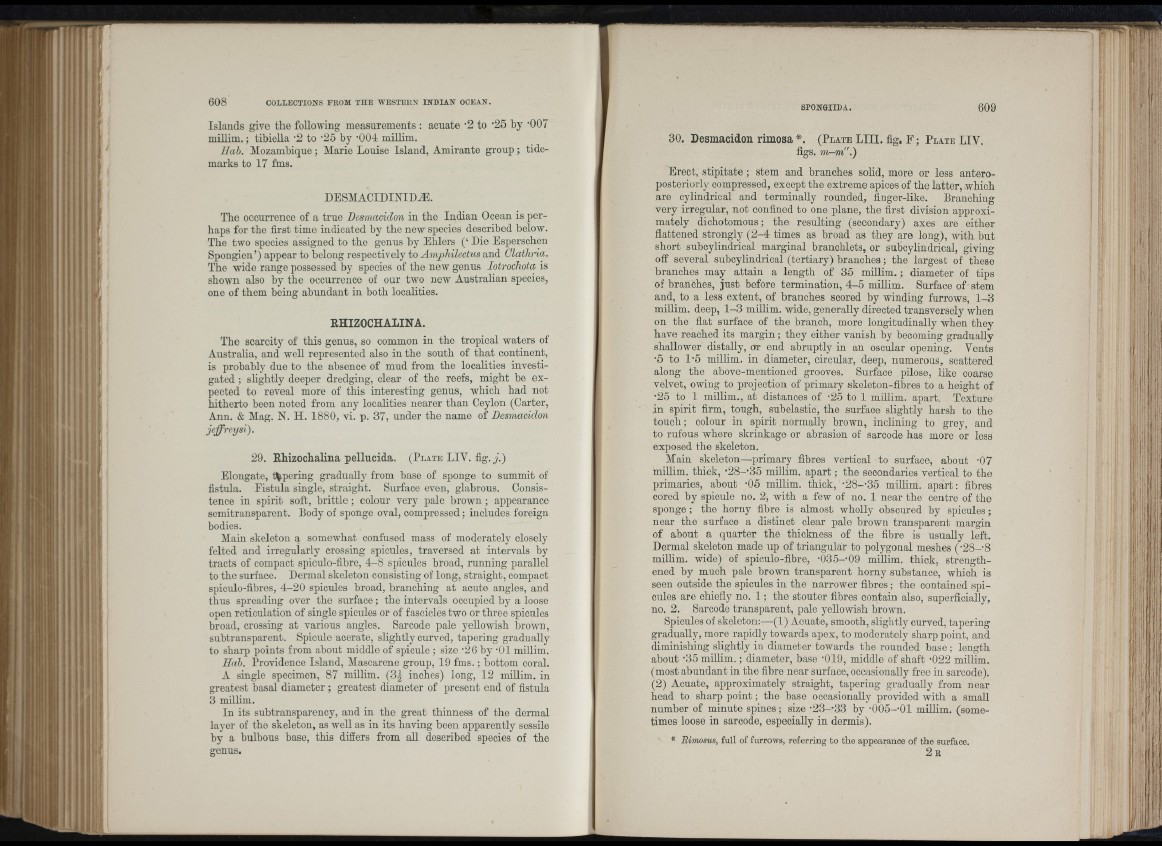
1 3 1
r ” ,
Islands give the foUowing measurements : acuate ’2 to '25 by *007
miUim.; tibiella -2 to -25 by -004 miUim.
Uab. Mozambique; Marie Louise Island, Amirante group; tidemarks
to 17 fms.
DESMACIDINIDÆ.
The occurrence of a true Desmacidon in the Indian Ocean is perhaps
for tbe first time indicated by the new species described below.
Tbe two species assigned to the genus by Ehlers ( ‘ Die Esperschen
Spongien’) appear to belong respectively to Amphilectus and Olathria.
Tbe wide range possessed by species of tbe new genus lotrochota is
shown also by the occurrence of our two new Australian species,
one of them being abundant in botb localities.
RHIZOCHALINA.
Tbo scarcity of tbis genus, so common in the tropical waters of
Australia, and well represented also in tbe south of th a t continent,
is probably due to the absence of mud from tbe localities investigated
; slightly deeper dredging, clear of the reefs, might be expected
to reveal more of tbis interesting genus, wbicb bad not
hitherto been noted from any localities nearer than Ceylon (Carter,
Ann. & Mag. N. H. 1880, vi. p. 37, under tbe name of Desmacidon
jeffreysi).
29. Rbizocbalina pellucida. ( P l a t e LIV. fig./.)
Elongate, tapering graduaUy from base of sponge to summit of
fistula. Eistula single, straight. Surface even, glabrous. Consistence
in spirit soft, brittle ; colour very pale brown ; appearance
semitransparent. Body of sponge oval, compressed ; includes foreign
bodies.
Main skeleton a somewhat confused mass of moderately closely
felted and irregularly crossing spicules, traversed at intervals by
tracts of compact spiculo-fibre, 4 -8 spicules broad, running parallel
to the surface. Dermal skeleton consisting of long, straight, compact
spiciUo-fibres, 4 -20 spicules broad, branching at acute angles, and
thus spreading over tbe surface ; tbe intervals occupied by a loose
open reticulation of single spicules or of fascicles two or three spicules
broad, crossing at various angles. Sarcode pale yeUowish brown,
suhtransparent. Spicule acerate, slightly curved, tapering graduaUy
to sbarp points from about middle of spicule ; size *26 by -01 millim.
Hab. Providence Island, Alascarene group, 19 fms. ; bottom coral.
A single specimen, 87 millim. (3^ inches) long, 12 miUim. in
greatest basal diameter ; greatest diameter of present end of fistula
3 miUim.
In its snbtransparency, and in tbe great thinness of the dermal
layer of tbe skeleton, as well as in its having been apparently sessile
by a bulbous base, tbis differs from aU described species of tbo
genus.
S P O N G I L D A . 609
30. Desmacidon rimosa *. ( P l a t e L I II . fig. F ; P l a t e LIV.
figs. m-m".)
Erect, stipitate ; stem and branches solid, more or less antero-
postoriorly compressed, except tbe extreme apices of tbe latter, wbicb
are cylindrical and terminally rounded, finger-like. Praucbing
very irregular, not confined to one plane, tbe first division approximately
dichotomous; tbe resulting (secondary) axes are either
flattened strongly (2 -4 times as broad as tbey are long), with but
short subcylindrical marginal branchlets, or subcylindrical, giving
off several subcylindrical (tertiary) branches ; tbe largest of tbese
branches may attain a length of 35 mUlim. ; diameter of tips
of branches, ju st before termination, 4 -5 miUim. Surface of stem
and, to a less extent, of branches scored by winding furrows, 1-3
millim. deep, 1 -3 miUim. wide, generaUy directed transversely when
on the flat surface of tbe branch, more longitudinally wben tbey
have reached its margin ; tbey either vanish by becoming graduaUy
shallower distaUy, or end abruptly in an oscular opening. Vents
•5 to 1-5 millim. in diameter, circular, deep, numerous, scattered
along tbe above-mentioned grooves. Surface pilose, like coarse
velvet, owing to projection of primary skeleton-fibres to a height of
•25 to 1 millim., at distances of -25 to 1 millim. apart. Texture
in spirit firm, tough, subelastic, tbe surface slightly harsh to tbe
touch; colour in spirit normally brown, inclining to grey, and
to rufous where shrinkage or abrasion of sarcode has more or loss
exposed the skeleton.
Main skeleton—primary fibres vertical to surface, about -07
miUim. thick, -28--35 milbm. apart ; tbe secondaries vertical to the
primaries, about -05 millim. thick, ■28--35 millim. apart: fibres
cored by spicule no. 2, with a few of no. 1 near tbe centre of the
sponge ; tbe horny fibre is almost wholly obscured by spicules ;
near the surface a distinct clear pale brown transparent margin
of about a quarter the thickness of the fibre is usuaUy left.
Dermal skeleton made up of triangular to polygonal meshes (-28--8
millim. wide) of spiculo-fibre, -035--09 millim. thick, strengthened
by much pale brown transparent horny substance, wbicb is
seen outside tbe spicules in tbe narrower fibres ; the contained spicules
are chiefly no. 1 ; the stouter fibres contain also, superficially,
no. 2. Sarcode transparent, pale yellowish brown.
Spicules of skeleton:—(1) Acuate, smooth, slightly curved, tapering
gradually, more rapidly towards apex, to moderately sharp point, and
diminishing slightly in diameter towards the rounded base ; length
about '35 miUim.; diameter, base '019, middle of sbaft -022 millim.
(most abundant in tbe fibre near surface, occasionally free in sarcode).
(2) Acuate, approximately straight, tapering gradually from near
bead to sharp p o in t; tbe base occasionally provided witb a small
number of minute spines; size -23--33 by •005--01 miPim. (sometimes
loose in sarcode, especially in dermis).
* Eimosus, M l o f f u r r o w s , r e f e r r i n g t o t h e a p p e a r a n c e o f t h e s u r f a c e .
2 E
1 [ I
tel
I *
I I
i|!|
te iii
■i * iSiI
I
■ F
¡i , F
IK"!
I A
lüii
, I